The tiny island of Gavrinis guards the turbulent entrance to Brittany’s Gulf of Morbihan.
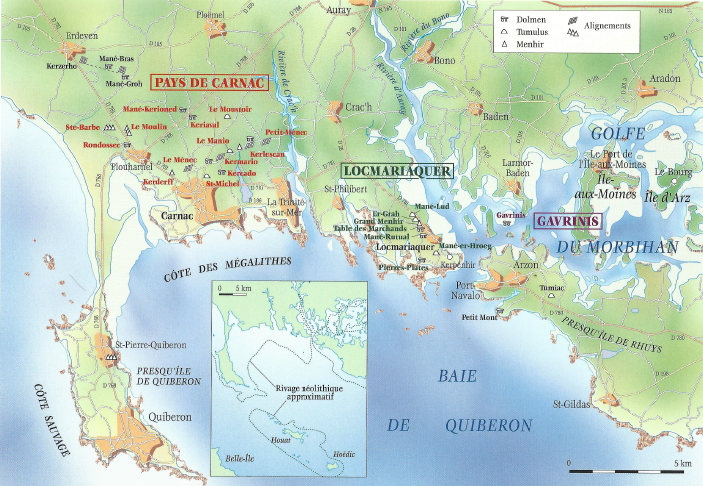
To get there, we took a beautiful 10 minute boat ride from the tiny village of Lamor-Baden.
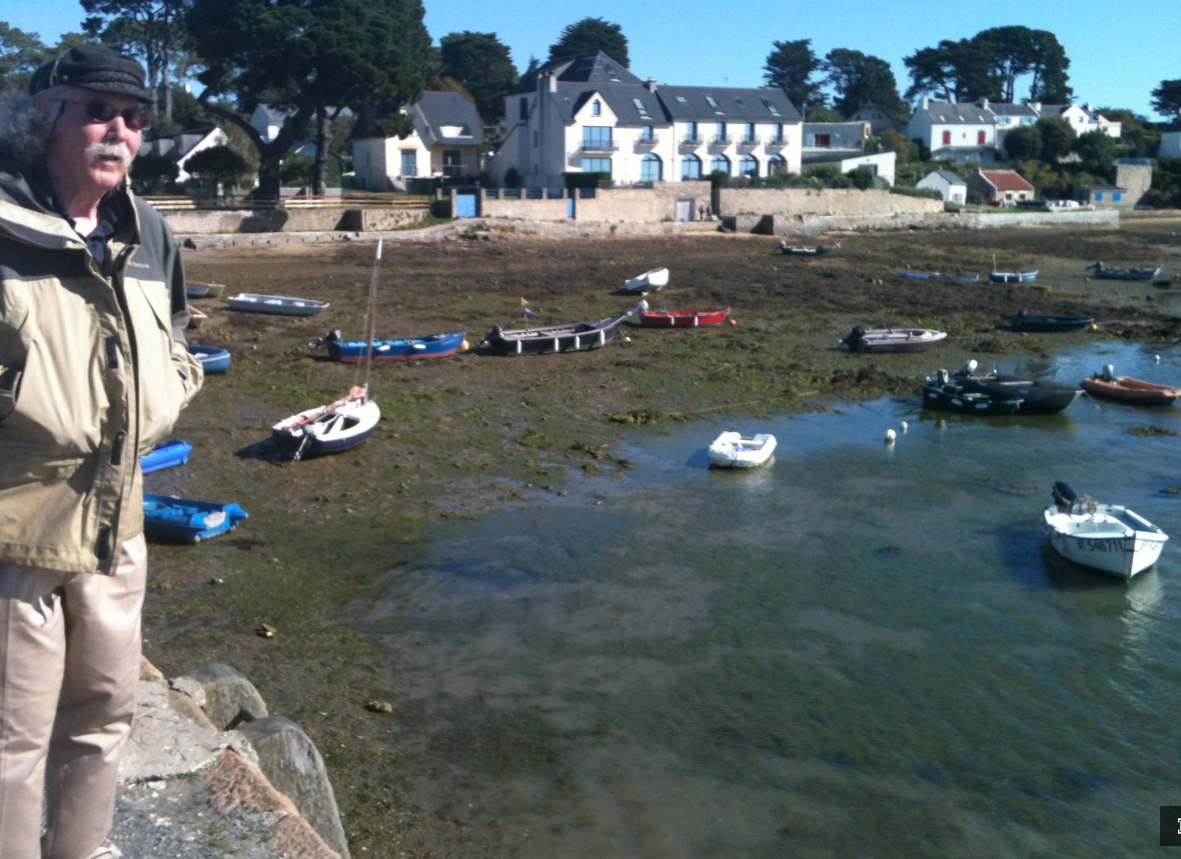
Perched on the island’s highest point is a spectacular tumulus.
Actually it’s a tumulus covering a cairn, covering a dolmen.*
And it’s old. Built in 3500 BCE during the Neolithic Era, it is older than the Great Pyramid of Giza and even a few centuries older than Newgrange, its more famous Irish cousin.
And it’s really big. At 100 meters in diameter, it’s bigger than Newgrange.
And the 46 foot long passageway leading to the central chamber is made up of huge stones carved in fantastic patterns that seem to shimmer and pulse. Several sources state flatly that they are some of the most magnificent art humanity has produced, a masterpiece of universal art.
And it’s prominently placed. When it was built, sea level was much lower and it was part of the mainland. It would have overlooked a large inlet that could have served as a major Neolithic seaport.

And it’s a riddle of a dolmen wrapped in an enigmatic cairn inside a mysterious tumulus.
• Why was it built? Like the even older alignments at Carnac, no one knows. The ranger on Gavrinis assured me that they had found human remains at the site, but none of my other sources mention this. So was it a tomb? A temple? A public meeting place? All of the above? Some of the above? None of the above? It had to have been something really important to get a primitive farming society (at least we think it was a primitive farming society) to move all those rocks and all that dirt, and carve all those stones using only round quartz pebbles—remember, this is the Neolithic Age, no metal.
• Are those images carved so laboriously on those stones just pretty designs or do they mean something?
We know that the Egyptian temple and tomb decorations were dense with meaning because we can read the pretty pictures (hieroglyphs) carved all over them. But no Rosetta Stone exists for the Neolithic Age. We can only speculate, and we’ve done lots of that. **
• Why was the wooden outer façade burned to cinders and the passageway to the central chamber blocked and filled with rubble only a few centuries after it was built?
• Why isn’t the southeast facing entryway aligned with the rising of the Winter Solstice sun? Newgrange is aligned to the Winter Solstice sunrise which has illuminated its chambers for over 5 millennia, and it would be convenient to assume the same at Gravinis. Unfortunately, although other sources claim that the rising Winter Solstice sun shines on the back of the central chamber, the source I trust most says that this is definitely not true. The opening is just slightly too far south for this to happen.*** This means that the sun will never shine inside this structure because the sun is at its southern-most point at Winter Solstice.
Which brings me to the final small, but still fascinating, mystery of Gavrinis that no one ever mentions.
A large and venerable oak tree grows from the southern base of the tumulus, and if you look south from that, there is a large holly tree. Oaks are plentiful throughout Brittany, but hollies, although native to the area, aren’t nearly as common. This was the first one I’d seen.
They form a north-south line**** which begins with the holly tree in the south and ends with the oak tree in the north.
Winter Solstice? Oak and Holly? My pagan brain immediately spits out the ancient Celtic myth of the Oak King and the Holly King who fight for dominance every year. The Oak King always wins at Winter Solstice and begins to gain power and the Holly King always wins at Summer Solstice and begins to gain power. Their never ending battle portrays the cycle of the seasons and reminds us of the universal paradox—everything changes, yet everything remains the same. It also reveals the Mystery of Winter Solstice: Out of the heart of darkness, at the time of the Holly King’s greatest power, the light of the Oak King is reborn.
• But who planted the oak tree and the holly tree at Gavrinis?
• And are these the first ones?
• Or are they replants of a long line of oaks and hollies stretching back to when?
• Perhaps to the first Celts to inhabit the area?
• Or did the Celts get the story of the Oak King and the Holly King from the descendants of the people who built the tumulus? In that case the first trees may have been planted way back in the fourth millennium BC?
• And then there is the chivalric romance of Sir Gawain and the Green Knight, in which a beautiful Green
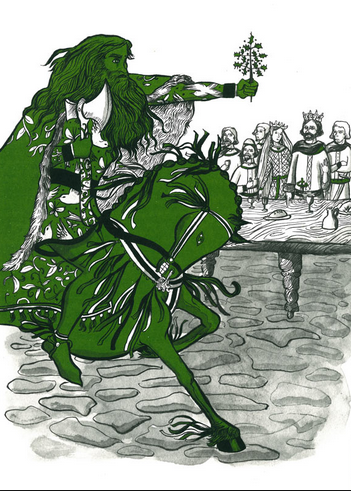
Knight on a green stallion rides into King Arthur’s banquet hall just after Christmas carrying a sprig of holly and challenges him to a duel, which is taken up by Gawain who beheads the visitor, who then picks up his head and leaves with Gawain’s promise to come and allow him to cut off Gawain’s head next year.Could this be a “modernized” version of the ancient Celtic myth which was a “modernized” version of an ancient Neolithic myth?
We will never be able to definitively solve all the mysteries of Gavrinis. The answers are lost in the mists of time. But perhaps, at this late date, the truth isn’t as important as what we believe to be true.
A blessed and contemplative Winter Solstice to all.
*Tumulus: An ancient, earthen burial mound, barrow. Cairn: A mound of rough stones built as a memorial or landmark. Dolmen: A megalithic structure composed of a large flat stone laid on two upright ones. They appear singly or lined up to form a passageway.
** The Megalithic Science website ran an article that explains how the designs on a section of Gavrinis Stone R8 depict the integration of two astronomic cycles: The Saros cycle, made up of 19 eclipse years of 364.62 days and the Metonic Cycle, made up of 19 solar years of 365.2422 days.
This means that the people who carved these stones were able to keep a very accurate calendar and predict solar and lunar eclipses. The Chaldeans (612-539BC) were the first culture we know of that had this capability, but Gavrinis stone R8 was carved 3,000 years before the Chaldeans existed.
Another website opines that “The concentric arches engraved in the stone(s) are careful depictions of the (non-linear) standing waves generated by baritone chanting at the entrance of the passage chamber, constructed with the appropriate length and width to allow reflected sound waves to retrace the same wavepath as it moves in both directions.”
In a Notes to Ponder post, the author describes how a computer with a pattern recognition program, analyzed the patterns on a few of the passageway stones and decided that some were symbols for the number of days in a year, the exact latitude and longitude of Gavrinis, and the mathematical constant Pi. (unfortunately, no references were given) If this information is really coded into the patterns, it sounds to me like the information in the scientific part of the golden records we put in Voyager I and II. Could the Neolithic cultures have understood that eventually they would be forgotten and left these amazing monuments of stone to remind the cultures that would follow them that they existed and they too had knowledge and power?
***Carnac, Locmariaquer, and Gavrinis, Text by Charles-Tanguy Le Roux, Photographs by Yvon Boelle, Editions Ouest-France, Edilarge S.A., 2011. The Carnac Museum of Prehistory sells this booklet in their gift shop and recommends it. The author is an authority on the Neolithic Age in Brittany.
****The line definitely runs north-south, but we didn’t have a compass to determine if it runs exactly north-south; and, if so, whether it’s aligned to true or magnetic north.
***** Many believe that the Arthurian legends were set in Brittany, not England. And there are many places along the coast of Brittany named for Camelot’s inhabitants.


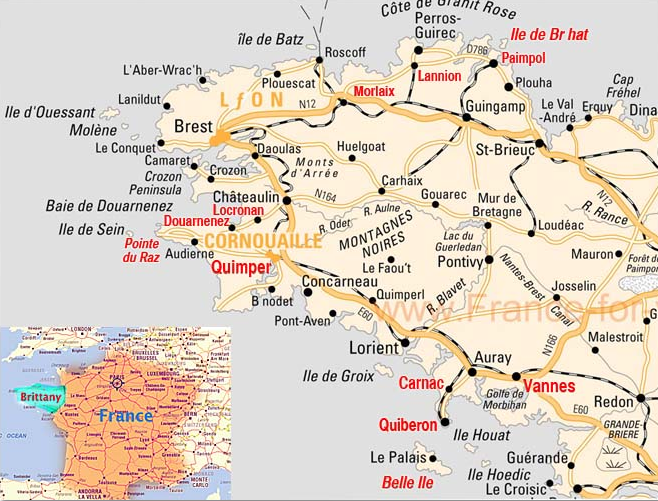
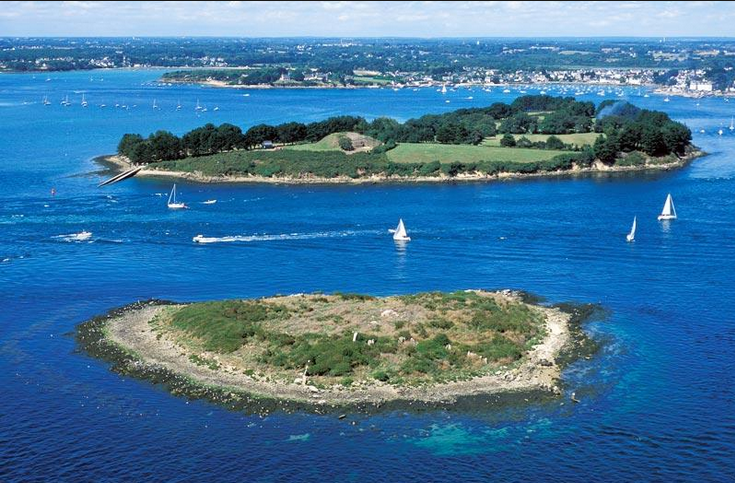
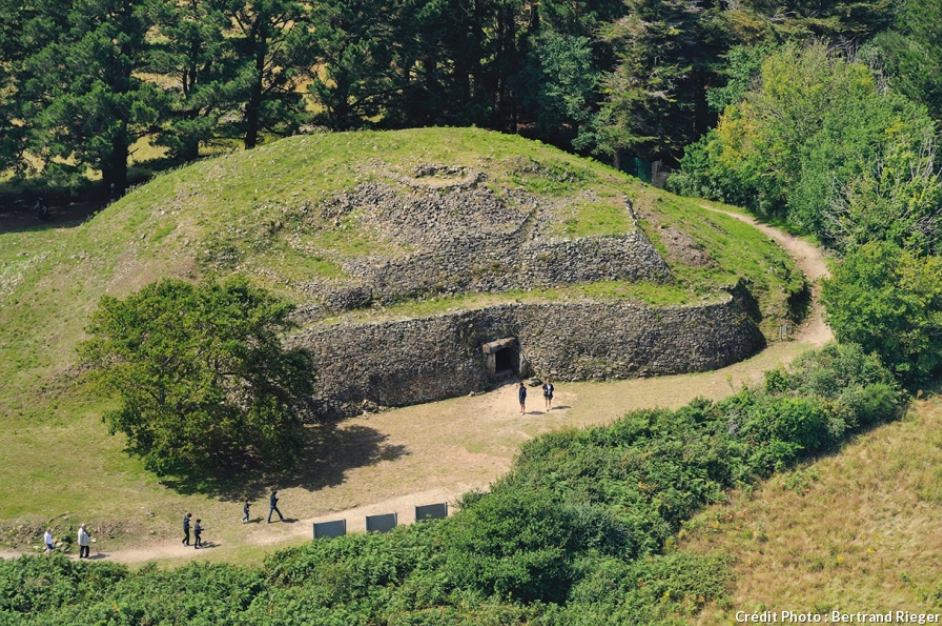
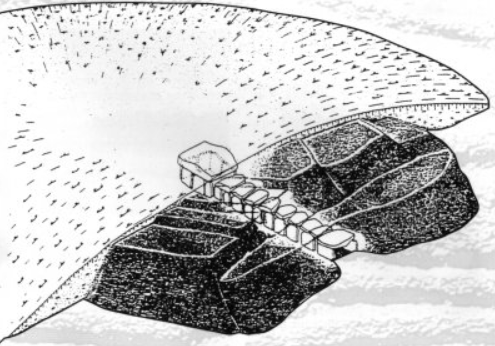
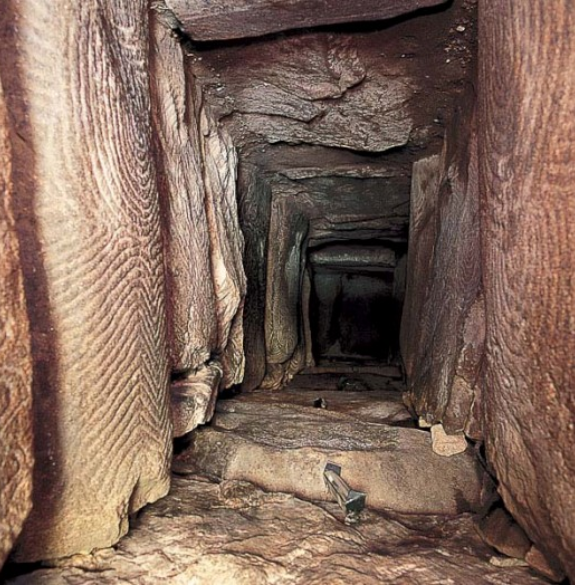
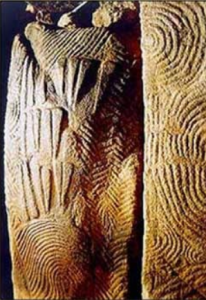
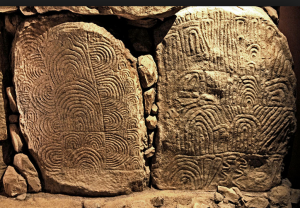
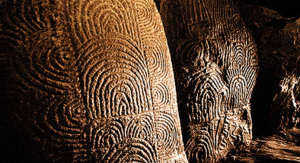
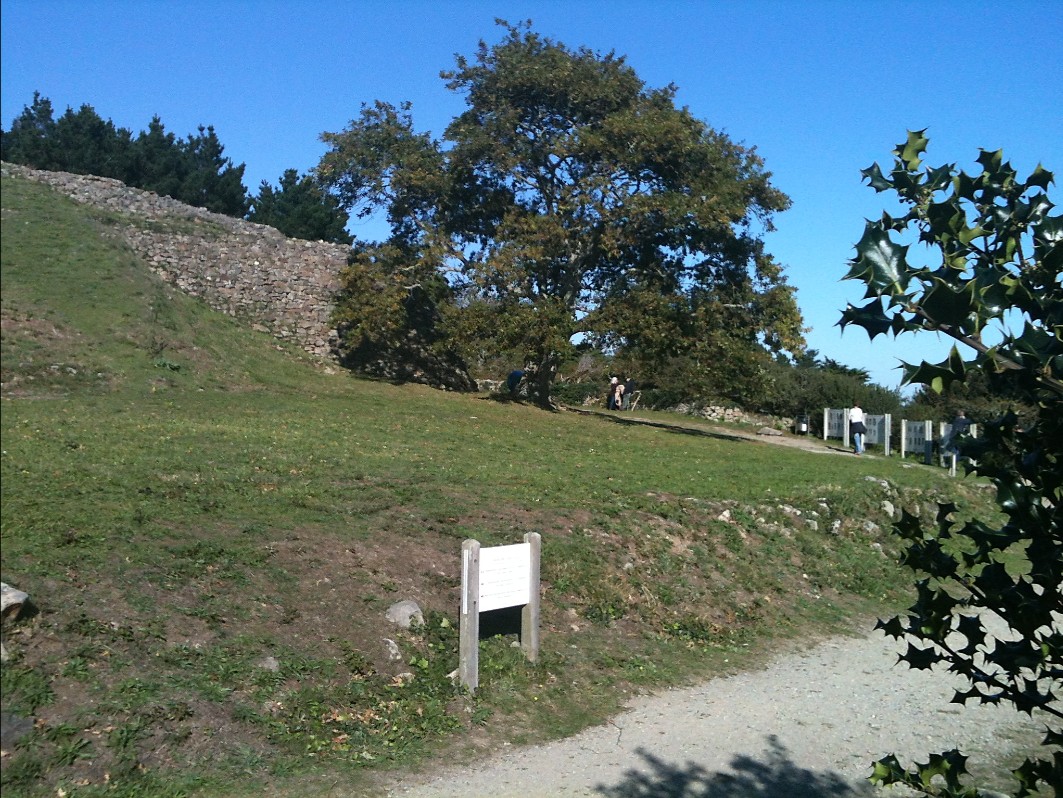



4 thoughts on “The Gravinis Tumulus and the Holly King and the Oak King”
Fascinating tumulus on an island nevertheless. I must visit it….thanks!
In one spot in particular, those designs carved in the walls remind me of fingerprints.
Sorry to be so slow. This is a wonderful post. Thank you for sharing and all your wonderful research. We are so blessed to have your beautiful spirit among us! Namaste’
I feel blessed to be able to visit these places.
Glad you enjoyed the post.